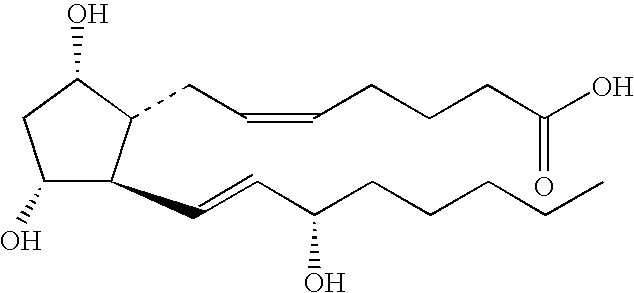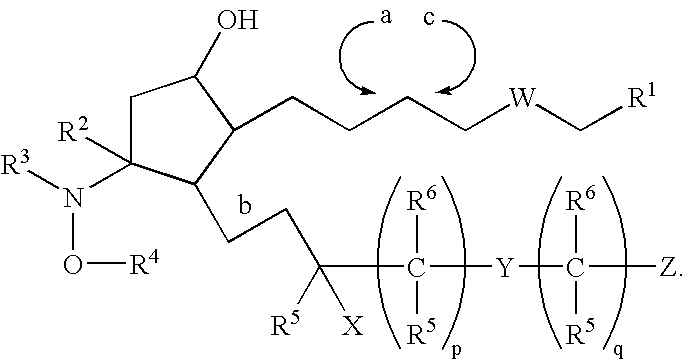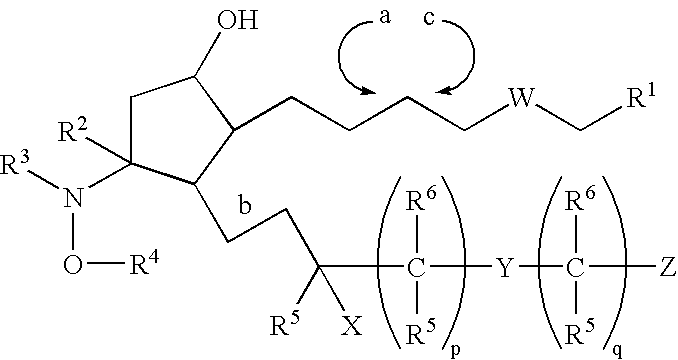Compositions and methods for treating hair loss using oximyl and hydroxylamino prostaglandins
a technology of prostaglandins and oximyl, which is applied in the field of compositions and methods for treating hair loss in mammals, can solve the problems of onset of full or partial baldness, partial or full baldness, and ongoing search for efficacious hair growth inducers
- Summary
- Abstract
- Description
- Claims
- Application Information
AI Technical Summary
Benefits of technology
Problems solved by technology
Method used
Image
Examples
reference example 1
Radioligand Binding Assay
[0180] IC50 of a prostaglandin can be determined relative to PGF2α using the Radioligand Binding Assay. As a control, the IC50 for PGF2α itself should be no lower than 1.0 nM and no higher than 5.0 nM.
[0181] In this assay, COS-7 cells are transiently transfected with the hFP recombinant plasmid using LipofectAMINE Reagent. Forty-eight hours later, the tranfected cells are washed with Hank's Balanced Salt Solution (HBSS, without CaCl2, MgCl2, MgSO4, or phenol red). The cells are detached with versene, and HBSS is added. The mixture is centrifuged at 200g for 10 minutes, at 4° C. to pellet the cells. The pellet is resuspended in Phosphate-Buffered Saline-EDTA buffer (PBS; 1 mM EDTA; pH 7.4; 4° C.). The cells are disrupted by nitrogen cavitation (Parr model 4639), at 800 psi, for 15 minutes at 4° C. The mixture is centrifuged at 1000 g for 10 minutes at 4° C. The supernatant is centrifuged at 100,000 g for 60 minutes at 4° C. The pellet is resuspended to 1 mg...
reference example 2
Telogen Conversion Assay
[0183] Prostaglandins are tested for their potential to grow hair using the Telogen Conversion Assay. The Telogen Conversion Assay measures the potential of a prostaglandin to convert mice in the resting stage of the hair growth cycle (“telogen”), to the growth stage of the hair growth cycle (“anagen”).
[0184] Without intending to be limited by theory, there are three principal phases of the hair growth cycle: anagen, catagen, and telogen. It is believed that there is a longer telogen period in C3H mice (Harlan Sprague Dawley, Inc., Indianapolis, Ind.) from approximately 40 days of age until about 75 days of age, when hair growth is synchronized. It is believed that after 75 days of age, hair growth is no longer synchronized. Wherein about 40 day-old mice with dark fur (brown or black) are used in hair growth experiments, melanogenesis occurs along with hair (fur) growth wherein the topical application of hair growth inducers are evaluated. The Telogen Conve...
example 1
[0188] Compositions for topical administration are made, comprising:
Component1-11-2Prostaglandin (wt %)0.010.1IC50 of the Prostaglandin (nM)15150Ethanol (wt %)59.9959.9Propylene Glycol (wt %)20.0020.0Dimethyl Isosorbide (wt %)20.0020.0
[0189] The prostaglandins used are shown below:
SampleProstaglandin1-11-2
A human male subject suffering from male pattern baldness is treated by a method of this invention. Specifically, for 6 weeks, one of the above compositions is daily administered topically to the subject to induce hair growth.
PUM
| Property | Measurement | Unit |
|---|---|---|
| temperature | aaaaa | aaaaa |
| temperature | aaaaa | aaaaa |
| temperature | aaaaa | aaaaa |
Abstract
Description
Claims
Application Information
 Login to View More
Login to View More - R&D
- Intellectual Property
- Life Sciences
- Materials
- Tech Scout
- Unparalleled Data Quality
- Higher Quality Content
- 60% Fewer Hallucinations
Browse by: Latest US Patents, China's latest patents, Technical Efficacy Thesaurus, Application Domain, Technology Topic, Popular Technical Reports.
© 2025 PatSnap. All rights reserved.Legal|Privacy policy|Modern Slavery Act Transparency Statement|Sitemap|About US| Contact US: help@patsnap.com



